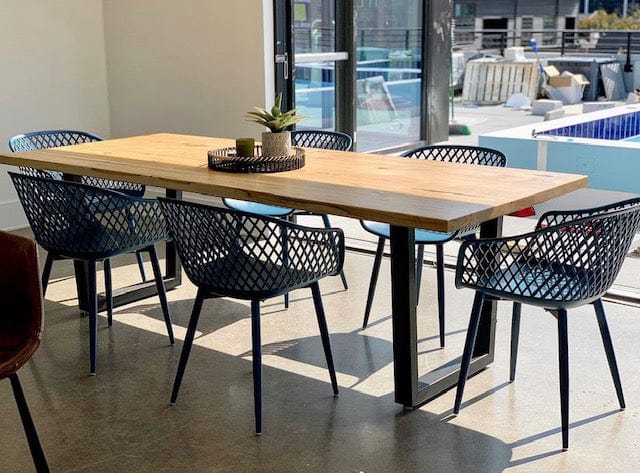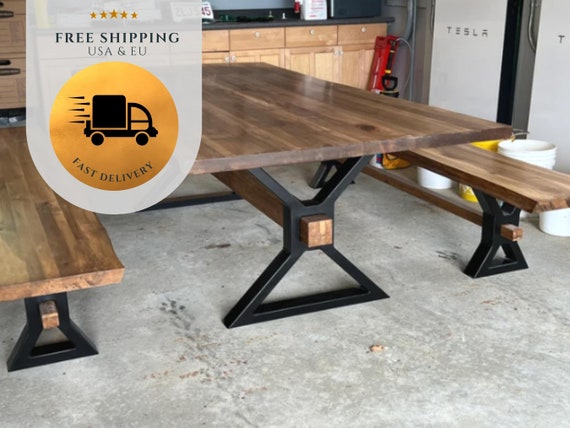The Best Materials for Durable and Elegant Dining Room Table Legs
The Best Materials for Durable and Elegant Dining Room Table Legs
Blog Article
From Conventional to Modern: Discover the Ideal Dining-room Table Legs for Your Design
The option of dining-room table legs plays a pivotal role in specifying the total character of your area, linking the void in between traditional workmanship and modern looks. While classic styles such as cabriole and turned legs stimulate a feeling of classic elegance, modern designs like barrette and geometric options offer a possibility for striking visual passion. Evaluating the best balance in between these styles requires a nuanced understanding of your existing design and individual taste. As you take into consideration these aspects, the inquiry stays: how can you effortlessly incorporate these diverse leg styles to develop an unified eating experience?
Understanding Table Leg Styles
The range of eating space table leg styles can substantially influence both the aesthetics and performance of the space. Each leg design adds distinct visual aspects and practical attributes, satisfying varied style choices and use requirements. Comprehending these designs is essential for selecting the ideal eating table that straightens with your total indoor style vision.
As an example, tapered legs supply a clean, classic look that can boost a space's beauty, while stand bases give stability and make best use of legroom, making them perfect for smaller rooms. Barrette legs, a characteristic of mid-century contemporary design, introduce an industrial flair, enabling an airy, open feel. Similarly, trestle legs stimulate rustic appeal, giving robust support and a feeling of eternity.
Additionally, the option of materials plays a significant duty. Wood legs can bring heat and appearance, whereas steel options typically communicate a smooth, modern ambiance. Eventually, understanding table leg styles is important for creating a cohesive eating area that mirrors individual style while ensuring usefulness and comfort. By thoughtfully considering these aspects, you can enhance both the aesthetic and functional allure of your eating area.
Conventional Table Leg Options
When selecting dining space table legs, traditional alternatives usually symbolize classic elegance and craftsmanship. These designs reflect an abundant heritage and a commitment to high quality, making them perfect for those that appreciate traditional visual appeals.
One of the most legendary standard leg styles is the cabriole leg, characterized by its stylish bent form. This style usually features ornamental carvings and is most commonly discovered in Queen Anne and Chippendale furnishings. An additional prominent option is the turned leg, which boasts a series of smooth, rounded forms that offer a classic appearance while keeping stability.
Furthermore, the straight leg, while easy, supplies a strong and unadorned structure that can blend flawlessly with a variety of tabletop designs. For those attracted to ornate outlining, claw-and-ball feet legs evoke a feeling of splendour and can work as a spectacular focal point in any eating area.
Finally, pedestal bases, although not purely legs, offer an alternate traditional option that enables enough legroom and can be beautifully sculpted. Each of these standard leg styles adds to the total atmosphere of a dining area, weding function with visual appeal.

Modern Table Leg Layouts
Modern table leg styles offer a varied variety of designs that emphasize cutting-edge materials and clean lines. These designs typically focus on functionality while serving as striking centerpieces within a dining room. Minimal appearances prevail, with legs crafted from materials such as steel, glass, and engineered wood, which contribute to a modern and airy feeling.
One preferred style is the barrette leg, defined by its slender, conical structure that explanation offers security without overwhelming the table top (dining room table legs). This design is typically discovered in mid-century modern furnishings and can easily complement numerous table shapes. Another fad is making use of geometric forms, where legs may take on unbalanced or angular forms, adding visual rate of interest and a touch of creativity

Blending Designs for One-of-a-kind Spaces
Often, house owners look for to create special eating areas that reflect their personal style by blending different layout components. This technique enables for the consolidation of varied appearances, causing a harmonious yet distinctive environment. For example, matching a rustic wooden table with streamlined, contemporary metal legs can develop a distinctive contrast that elevates the space's overall allure.
Furthermore, integrating vintage table legs with modern tabletops can evoke a click over here feeling of background while keeping a modern perceptiveness. Such combinations not just display specific preference however additionally urge creativity, allowing homeowners to curate a room that feels both individual and welcoming.
Shade plays an important function in this mixing process; choosing table legs that enhance or comparison with the existing color design can enhance visual passion. For instance, whitewashed legs can soften the boldness of a dark table surface, creating a well balanced aesthetic.
Tips for Selecting the Right Legs
Picking the right table legs is important for accomplishing both performance and visual appeal in your dining room. Begin by thinking about the overall style of your space. Typical setups gain from legs that include intricate makings or transformed styles, while modern areas might ask for streamlined, minimal designs.
Next, assess the elevation and security of the legs. dining room table legs. Basic table vary between 28 to 30 inches in height, so make sure the legs enhance this dimension for convenience. In addition, durable materials, such as wood or steel, can improve security and longevity
Review the leg shape too-- alternatives consist of right, tapered, or pedestal layouts. Straight legs offer a classic look, while tapered legs can add a touch of elegance. Pedestal bases supply sufficient legroom and are optimal for smaller areas.
Verdict
In summary, choosing the perfect dining room table legs calls for careful consideration of both conventional and contemporary designs. By harmonizing leg design, elevation, and material with the total décor, a natural and inviting atmosphere can be attained.
The range of dining room table leg designs can substantially influence both the aesthetic appeals and performance of the space. Inevitably, comprehending table leg designs is necessary for creating a cohesive dining location that shows individual style while guaranteeing usefulness and convenience.One of the most legendary traditional leg designs is the cabriole leg, identified by its elegant curved shape. Straight legs offer a timeless look, while conical legs can include a touch of beauty.In summary, choosing the ideal dining area table legs requires careful consideration of both modern and you could try this out conventional designs.
Report this page